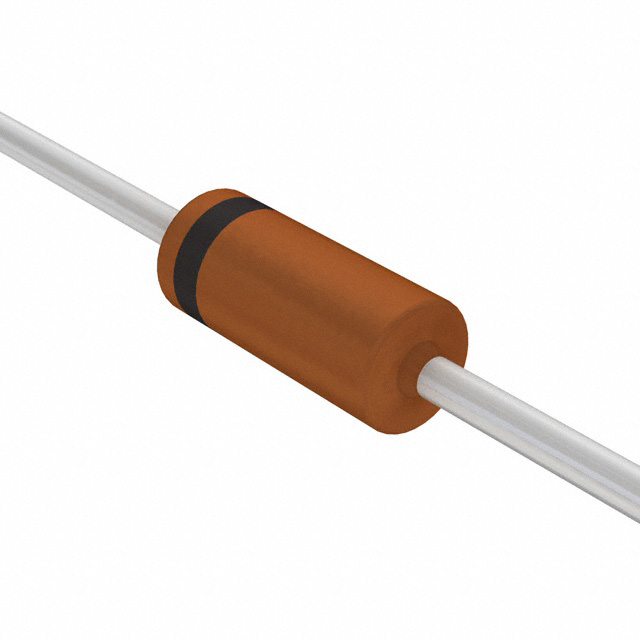Consulte las especificaciones para obtener detalles del producto.

BZX79B3V3 A0G
Product Overview
Category
The BZX79B3V3 A0G belongs to the category of Zener diodes.
Use
It is commonly used for voltage regulation and protection in electronic circuits.
Characteristics
- Zener voltage: 3.3V
- Power dissipation: 500mW
- Package type: DO-35
- Operating temperature range: -65°C to +200°C
- Forward voltage: 1.2V
- Reverse current: 5µA
Package
The BZX79B3V3 A0G is typically available in reels or tubes, with varying quantities depending on the supplier.
Essence
The essence of the BZX79B3V3 A0G lies in its ability to provide a stable and precise voltage reference in electronic circuits.
Specifications
- Zener voltage: 3.3V ±5%
- Power dissipation: 500mW
- Maximum forward voltage: 1.2V
- Maximum reverse current: 5µA
- Package type: DO-35
- Operating temperature range: -65°C to +200°C
Detailed Pin Configuration
The BZX79B3V3 A0G has two pins and follows the standard pin configuration for Zener diodes, with the anode connected to the positive terminal and the cathode connected to the negative terminal.
Functional Features
- Precise voltage regulation at 3.3V
- Protection against voltage spikes and surges
- Low reverse current for minimal power loss
- Wide operating temperature range for versatility in various applications
Advantages and Disadvantages
Advantages
- Stable and precise voltage reference
- Compact package size
- Wide operating temperature range
Disadvantages
- Limited power dissipation capability compared to higher wattage diodes
- Sensitive to excessive current and voltage levels
Working Principles
The BZX79B3V3 A0G operates based on the Zener effect, where it maintains a constant voltage drop across its terminals when reverse-biased, providing a stable reference voltage for the circuit.
Detailed Application Field Plans
The BZX79B3V3 A0G finds extensive use in various electronic applications, including: - Voltage regulation in power supplies - Overvoltage protection in communication systems - Signal clamping in audio and video circuits - Voltage reference in precision measurement instruments
Detailed and Complete Alternative Models
Some alternative models to the BZX79B3V3 A0G include: - BZX79B3V9 A0G - BZX79B4V3 A0G - BZX79B5V1 A0G - BZX79B6V2 A0G - BZX79B7V5 A0G
These alternatives offer different Zener voltages to suit specific application requirements.
This comprehensive entry provides detailed information about the BZX79B3V3 A0G Zener diode, covering its specifications, functional features, advantages, disadvantages, working principles, application field plans, and alternative models.
Enumere 10 preguntas y respuestas comunes relacionadas con la aplicación de BZX79B3V3 A0G en soluciones técnicas
What is the BZX79B3V3 A0G?
- The BZX79B3V3 A0G is a 3.3V Zener diode with a power dissipation of 500mW and a tolerance of ±5%.
What are the typical applications of the BZX79B3V3 A0G?
- It is commonly used in voltage regulation, voltage reference, and overvoltage protection circuits.
What is the maximum power dissipation of the BZX79B3V3 A0G?
- The maximum power dissipation is 500mW.
What is the voltage tolerance of the BZX79B3V3 A0G?
- The voltage tolerance is ±5%.
What is the operating temperature range of the BZX79B3V3 A0G?
- The operating temperature range is typically -65°C to +150°C.
How does the BZX79B3V3 A0G provide voltage regulation?
- It maintains a constant output voltage across its terminals, even when there are variations in input voltage or load current.
Can the BZX79B3V3 A0G be used for overvoltage protection?
- Yes, it can be used to limit the voltage across a circuit to a safe level by shunting excess current.
What are the key characteristics of the BZX79B3V3 A0G that make it suitable for technical solutions?
- Its small size, high reliability, and precise voltage regulation capabilities make it ideal for various technical applications.
What are the potential drawbacks of using the BZX79B3V3 A0G in a technical solution?
- It may have limitations in handling high power dissipation or large current surges.
Are there any specific considerations for integrating the BZX79B3V3 A0G into a technical design?
- It's important to consider its thermal management, current limitations, and voltage derating to ensure optimal performance and reliability in the application.

